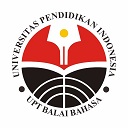Androgynous Representation in The Boy and The Heron: A Semiotic Approach to Visual and Linguistic Identity
Abstract
Keywords
Full Text:
PDFReferences
Atwood, S., & Axt, J. R. (2021). Assessing implicit attitudes about androgyny. Journal of Experimental Social Psychology, 96, 104162. https://doi.org/10.1016/j.jesp.2021.104162
Bem, S. L. (1974). The measurement of psychological androgyny. Journal of Consulting and Clinical Psychology, 42(2), 155–162. https://doi.org/10.1037/h0036215
Budiman, K. (2011). Semiotika visual: Konsep, isu, dan problem ikonisitas ([Cet. 1.]). Jalasutra.
Cheng, C. (2005). Processes Underlying Gender‐Role Flexibility: Do Androgynous Individuals Know More or Know How to Cope? Journal of Personality, 73(3), 645–674. https://doi.org/10.1111/j.1467-6494.2005.00324.x
Fadly WIjayakusuma, P. K. (2021). Less Masculine, More Feminine dan Less Feminine, More Masculine: Laki-laki Mengekspresikan Androgini Melalui Fashion. Emik, 3(2), 137–159. https://doi.org/10.46918/emik.v3i2.662
Huang, X., Zhu, X., Zheng, J., Zhang, L., & Shiomi, K. (2012). Relationships Among Androgyny, Self-Esteem, and Trait Coping Style of Chinese University Students. Social Behavior and Personality: An International Journal, 40(6), 1005–1014. https://doi.org/10.2224/sbp.2012.40.6.1005
Isaka, M. (2023). Masculinized femininity of women characters on the Kabuki stage: Female Onnagata’s “cross-gender” performance in the “all-male” theatre. Journal of Material Culture, 28(4), 539–558. https://doi.org/10.1177/13591835231211222
Kartini, K., Fatra Deni, I., & Jamil, K. (2022). Representasi Pesan Moral Dalam Film Penyalin Cahaya: Analisis Semiotika Charles Sanders Peirce. SIWAYANG Journal: Publikasi Ilmiah Bidang Pariwisata, Kebudayaan, Dan Antropologi, 1(3), 121–130. https://doi.org/10.54443/siwayang.v1i3.388
Kotani, M. (2006). Metamorphosis of the Japanese Girl: The Girl, the Hyper-Girl, and the Battling Beauty. Mechademia, 1(1), 162–169. https://doi.org/10.1353/mec.0.0090
McLeod, K. (2013). Visual Kei: Hybridity and Gender in Japanese Popular Culture. YOUNG, 21(4), 309–325. https://doi.org/10.1177/1103308813506145
Napier, S. (2001). Anime from Akira to Princess Mononoke: Experiencing Contemporary Japanese Animation (1st ed. 2001). Palgrave Macmillan US. https://doi.org/10.1057/9780312299408
Peirce, C. S. (1955). Philosophical writings of Peirce (J. Buchler, Ed.; 1. Publ., new ed., unabr. and unaltered republ. of the book 1. publ. 1940 under the title: The Philosophy of Peirce). Dover Publ.
Poleva, E. A. (2021). Androgynous motives in the novel “Pobeg Kumaniki” (“Bramble Sprout”) by Lena Eltang. Sibirskiy Filologicheskiy Zhurnal, 2, 148–160. https://doi.org/10.17223/18137083/75/11
Shibamoto-Smith, J. S. (2021). Japanese? Language? and Gender? Gender and Language, 15(4), 582–590. https://doi.org/10.1558/genl.21525
Sobur, A. (2003). Semiotika komunikasi. Remaja Rosdakarya.
Surya, R. A., & Kaluge, T. A. (2021). The State of Women and Women’s Education at the Beginning of Tokugawa Shogunate (1603-1651). IZUMI, 10(1), 119–130. https://doi.org/10.14710/izumi.10.1.119-130
Zulkifli, N. N., & Haris, N. ‘Anira. (2021). Brave (2012) vs Puteri (2014): The Representation of Androgyny Characters. International Journal of Advanced Research in Education and Society, 3(4), 56–74. https://doi.org/10.55057/ijares.2021.3.4.7
DOI: https://doi.org/10.17509/japanedu.v10i1.80299
Refbacks
- There are currently no refbacks.
Copyright (c) 2025 JAPANEDU: Jurnal Pendidikan dan Pengajaran Bahasa Jepang

This work is licensed under a Creative Commons Attribution-ShareAlike 4.0 International License.
 Published by:
Published by: Department of Japanese Language Education, Faculty of Language and Literature Education
Universitas Pendidikan Indonesia
 Online ISSN: Online ISSN:2528-5548 |

JAPANEDU: Jurnal Pendidikan dan Pengajaran Bahasa Jepang (e-ISSN:2528-5548) lisenced under a Creative Commons Attribution-ShareAlike 4.0 Internasional (CC BY-SA 4.0)


